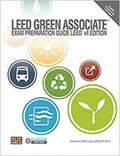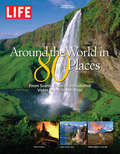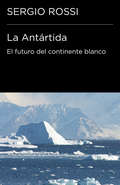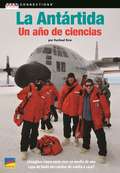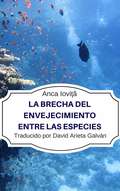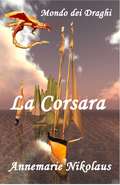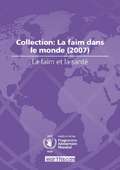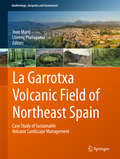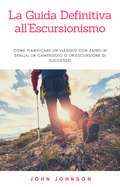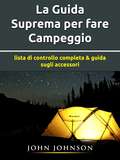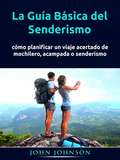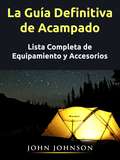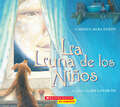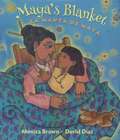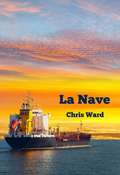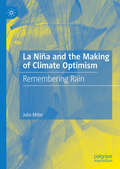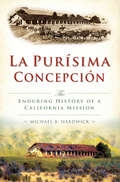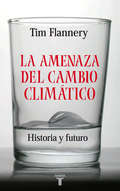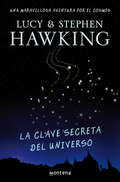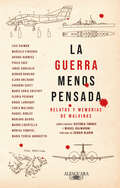- Table View
- List View
LEED Green Associate Exam Preparation Guide (v4 Edition)
by Heather C. McCombs<p>The LEED Green Associate Exam Preparation Guide, LEED v4 Edition is designed to help you pass the LEED Green Associate exam. The exam prep guide captures the critical points you need to know about green building. It also reflects the structure of the exam knowledge and task domains to organize foundational concepts in green building and LEED. <p>The exam prep guide will help you prepare for the exam by emphasizing key terms and providing application learning through practice questions. This resource is intended to be used in conjunction with the exam primary references, including the LEED Core Concepts Guide. Access to a variety of digital resources that enhance learning is also included with this guide.</p>
LIFE Around the World in 80 Places: From Scenic Cities to Sensational Vistas to the Seven Seas
by The Editors of LIFESee the world from an exciting new perspective with this inspiring visual guide of some of the world’s most beautiful and captivating places! Visit 80 of the most beautiful and thought-provoking wonders, all carefully curated to simulate eight round-the-world journeys. Dozens of stunning photos guide readers from cities and museums to mountains and lakes, to attractions and oddities and more. You’ll see many of the places you would expect, including dynamic cities and famous natural wonders. But there are some best-kept secrets here, too, including the Hill of Crosses in Lithuania and Dean’s Blue Hole in the Bahamas. The last section is dedicated to the attractions that are on everyone’s bucket list—the Great Wall of China, the Taj Mahal, Petra. The spirit of Jules Verne lives on in this unique collection that’s perfect for armchair travelers.
La Antártida. El futuro del continente blanco
by Sergio RossiEl biólogo Sergio Rossi, uno de los pocos privilegiados que ha pisado la mítica tierra de la Antártida, nos acompaña a bordo del buque alemán Polarstern hasta el "fin del mundo", la zona de Larsen, un lugar que los ojos del hombre no han visto jamás. Nos muestra la fauna y flora que habitan la superficie helada y los fondos marinos del continente blanco, y nos explica la importancia crucial de mantener su equilibrio para poder preservar también el equilibrio del planeta.
La Brecha del Envejecimiento Entre las Especies
by Anca IoviţăEl envejecimiento es un rompecabezas a resolver. Este proceso es tradicionalmente estudiado en algunos modelos biológicos como moscas de fruta, gusanos y ratones. Lo que todas estas especies tienen en común es su rápido envejecimiento. Esto es excelente para el presupuesto del laboratorio. Es una gran estrategia a corto plazo. ¿Quién tiene tiempo de estudiar especies que viven por décadas? Pero las diferencias de duración de vida entre las especies son magnitudes de orden mayor que cualquier variación lograda en el laboratorio. Esta es la razón por la cual estudié incontables fuentes de información en un intento por reunir información altamente especializada en un libro fácil de seguir. Quería ver el bosque entre los árboles. Quería exponer la brecha del envejecimiento entre las especies en una secuencia lógica y fácil de seguir. Este libro es mi intento de hacer precisamente eso. ¿Cuáles son los mecanismos subyacentes de la brecha de envejecimiento entre las especies? He elegido intencionalmente escribir la respuesta a esta cuestión en un lenguaje claro. La investigación del envejecimiento es muy importante como para enconderla tras las puertas cerradas del argot científica formal. Este libro podría no haber exisitdo si el té verde, las bibliotecas y el internet no hubieran sido inventados. La cantidad de datos que tuve que explorar para mantener los patrones esenciales es enorme. Sin embargo, el libro no es exhaustivo. No es un aburrido y académico libro de texto. Intenté infundir vida en un tema que es enormemente importante para la extensión de la esperanza de vida humana. Solo tú puedes decidir si lo logré. ***************** Tabla de Contenidos ********************** Encontrando el Bosque Entre los Árboles Ser Confiable Cuenta Las Matemáticas del Envejecimiento La Velocidad de la Senescencia Caso de Estudio: Envejecimiento en Peces Cómo Estimar
La Corsara: Un romanzo fantasy su navigatori, draghi ed elfi (Mondo dei Draghi #1)
by Annemarie NikolausMondo dei Draghi: Nanja, la corsara delle Isole Galleggianti, ruba una dozzina di cavalli dal continente più vicino. Un nobile dell'Isola dei Draghi vuole farli schierare contro i draghi autoctoni e consolidare il suo potere con lo spettacolo. Ma prima una bonaccia, poi un terremoto e infine un attacco dei demoni minacciano di rovinare l'affare di Nanja con il nobile. Sembra che i cavalli non debbano raggiungere l'Isola dei Draghi. Quindi, il committente di Nanja diventa il suo stesso nemico, perché ha bisogno dell'unico navigatore in grado di gestire i cavalli. Si impossessa di Ron e prende Nanja in ostaggio, affinché Ron vinca la corsa per lui. Ma quando Ron sarà nuovamente libero, non sarà affatto al sicuro... Ogni romanzo della collana è autoconclusivo.
La Faim et la Sante: Collection: La Faim dans le Monde (2007)
by World Food ProgrammeFirst published in 2008, La Faim et la Sant is a valuable contribution to the field of Environment and Sustainability.
La Garrotxa Volcanic Field of Northeast Spain
by Joan Martí Llorenç PlanagumàThis informative book takes readers on an enjoyable journey through the La Garrotxa volcanoes. In addition to a general description of the main geological and volcano logical values of the region, it also provides a detailed account of the history of the region, its biological diversity, and its cultural heritage including architecture, folklore and gastronomy. La Garrotxa Volcanic Zone was declared a Natural Park in 1982 to protect the numerous sites of special interest that are found in this region. The Natural Park has been pioneering in many initiatives aimed at preserving the landscape and natural values and promoting awareness of the area within the community. An important part of this book is dedicated to the insights into the educational programs and outreach developed to disseminate the main values of this region. It shows how sustainable tourism has been implemented and the management plan that has been designed to preserve such important natural and cultural values. Including local experts’ views on the topics covered, this book will appeal to a general audience interested not only in visiting the area but also in gaining insights into an example of geoheritage and geoconservation that has successfully integrated of education, tourism, planning and environmental management.
La Guida Definitiva all’Escursionismo: Come Pianificare un Viaggio con Zaino in Spalla, un Campeggio o un’Escursione di Successo
by John JohnsonStai cercando di darti all’escursionismo? Ti piacerebbe imparare a farlo come un professionista? Se la tua risposta è sì, allora questo è il libro che fa per te. Impara a muovere i primi passi, e tutto ciò che devi sapere su questo sport e su come praticare escursionismo, o trekking, come un professionista. Seguire queste tecniche e queste dritte sul campeggio ti aiuterà a muovere i primi passi e a fare escursionismo meglio che mai. Ti presento i segreti utilizzati dai professionisti per incamminarti sui terreni più ardui! Con decenni di strategie testate, questo ebook ti illustrerà il modo più rapido ed efficace per scoprire questo sport! Il libro comprende: - Primi passi. - Lista delle cose da fare. - Quali attrezzi utilizzare. - Come fare escursionismo - Preparazione + MOLTO ALTRO! Se vuoi essere più vigoroso ed avere migliori risultati nell’escursionismo, allora questa guida fa per te. --> Scorri in cima alla pagina e clicca su “aggiungi al carrello” per acquistare subito Informazioni legali: Questo autore e/o proprietario dei diritti non ha alcuna pretesa di garanzia nei confronti dell’accuratezza, completezza o adeguatezza del contenuto di questo libro, e nega espressamente ogni responsabilità per errori o omissioni nel suo contenuto. Questo prodotto è ad esclusivo uso di consultazione. Per favore consulta un professionista prima di intraprendere qualsiasi azione contenuta al suo interno.
La Guida Suprema per fare Campeggio: lista di controllo completa & guida sugli accessori
by John JohnsonVuoi avventurarti in campeggio? Ti piacerebbe imparare come fare camping come fanno i professionisti? Se hai risposto sì a queste domande, questo libro fa per te. Scopri come iniziare e tutto ciò che devi sapere sullo sport e come fare camping come un professionista. Verranno presentati i prodotti che i professionisti usano per scalare i terreni più difficili! Con decenni di strategie testate, questo ebook ti mostrerà il modo più veloce ed efficace per imparare a fare camping! Cosa è incluso: - Come iniziare. - Liste di controllo. - Quali attrezzi usare. - Come fare camping. - Preparazione. E MOLTO ALTRO! Se vuoi essere più forte ed efficace nel camping, allora questa guida è per te. -> Scorri fino all'inizio della pagina e fai clic su Aggiungi al carrello per acquistare immediatamente Dichiarazione di responsabilità: Questo autore e / o il / i proprietario / i dei diritti non fanno rivendicazioni, promesse o garanzie in merito all'accuratezza, completezza o adeguatezza dei contenuti di questo libro e declinano espressamente la responsabilità per errori e omissioni nei contenuti all'interno. Questo prodotto è solo per riferimento. Si prega di consultare un professionista prima di agire su uno qualsiasi dei contenuti presenti all'interno.
La Guía Básica del Senderismo: cómo planificar un viaje acertado de mochilero, acampada o senderismo
by John Johnson¿Está pensando en empezar a hacer senderismo? ¿Le gustaría aprender a hacer senderismo como lo hacen los profesionales? Si ha respondido afirmativamente a estas preguntas, entonces este libro es para usted. Aprenda cómo empezar, así como todo lo que necesita saber sobre el deporte y cómo hacer senderismo como un profesional. Estas técnicas básicas le ayudarán a empezar y a practicar el senderismo de la mejor manera posible. ¡Presentamos los secretos de los profesionales para empezar y seguir con las caminatas más difíciles! Con décadas de estrategias probadas, este libro le mostrará la forma más rápida y efectiva para practicar el deporte. Lo que incluye: - Cómo empezar - Qué llevar - Qué equipo usar - Cómo hacer senderismo - Cómo prepararse ¡Y mucho más! Si quiere estar más fuerte y ser más eficiente en el senderismo, entonces esta guía es para usted. --> Desplácese a la parte superior de la página y haga clic en añadir al carrito para comprar hoy mismo Exención de responsabilidad: Este autor y/o propietario(s) de los derechos no hace ninguna reclamación, promesa o garantía en relación con la exactitud, integridad o adecuación del contenido de este libro, y expresamente renuncia a la responsabilidad por errores y omisiones en el contenido del mismo. Este producto es solo para un uso de referencia. Por favor, consulte a un profesional antes de actuar sobre cualquiera de los contenidos que se encuentran en este libro.
La Guía Definitiva de Acampado: Lista Completa de Equipamiento y Accesorios
by John Johnson¿Estás buscando iniciarte en el arte de acampar? ¿Quieres aprender a acampar como lo hacen los profesionales? Si respondiste si a estas preguntas entonces este libro es para ti. Aprende como comenzar y todo lo que necesitas saber sobre acampar como lo hacen los profesionales. Usar estas técnicas y tips de acampado te ayudará a empezar y acampar mejor que nunca antes! Presentamos los secretos que los profesionales usan para escalar los terrenos más difíciles. Con décadas de estrategias comprobadas, este ebook te mostrará la forma más rápida y efectiva para aprender este deporte! Que incluye: - Empezando - Lista esencial - Que equipamiento usar - Como acampar - Preparaciones + MUCHO MÁS! Si quieres ser mejor y más efectivo a la hora de acampar, esta guía es para ti. --> Sube al principio de la página y haz click en el carrito para comprarlo inmediatamente Información Legal: Este autor y/o los dueño/s de los derechos no hacen declaraciones, promesas o garantías en referencia a la precisión, integridad o adecuación del contenido de este libro y expresamente renuncian a la responsabilidad por errores y omisiones en el contenido interno. Este producto es para uso de referencia unicamente. Por favor consulte a un profesional antes de tomar acción sobre cualquiera de los contenidos que se encuentran dentro.
La Leggenda di Ron Anejo
by Ed Teja Vita CumboNarra la leggenda che il Capitano Ron Anejo viva nella isole dei Caraibi, nessuno sa di preciso dove, ma è certo che laggiù tutti conoscano il suo nome, perchè se ti trovi nei guai, lui è l'uomo giusto per tirartene fuori, e, basterà chiedere di lui e sarà lui stesso a trovarti come ogni supereroe leggendario farebbe. Quando un uomo decide di avventurarsi nel mar dei Caraibi, solo, incosciente, senza alcuna esperienza nella navigazione, e con una visione un po' troppo romantica di cosa significhi vivere su di una barca ai tropici, allora questa non può che essere la premessa di una infinita serie di disgraziatissime e strampalate avventure. Questo tipo di avventure sono però proprio quelle che finiscono per rapirti il cuore e fare di un uomo qualunque un vero lupo di mare.
La Leyenda del Amazonas
by Daniel HernándezUna novela llena de aventura, emoción e intriga. <P><P>Héctor, tiene a su padre muy enfermo y los médicos no encuentran cura, el chico lee un artículo en el cual hablan sobre la existencia de una legendaria planta todo curativa en el corazón de la selva amazónica, sin pensarlo dos veces se embarca hacia Brasil, allí conoce tres jóvenes, los cuales se unirán a él y su causa, pero no son los únicos que van tras la valiosa hierba. <P><P>Los cuatro amigos se encontrarán en su camino con múltiples desafíos y contratiempos, pero los chicos están decididos a llevar sus planes a cabo y salvar la vida del padre de Héctor.
La Luna de los Niños (The Children´s Moon)
by Carmen Agra DeedyHave you ever seen the moon on a clear blue day and wondered why?Hubo un tiempo en que solo el sol reinaba en el día, la luna adornaba la noche y los niños pequeños se iban a la cama antes del anochecer. Pero entonces, una mañana, la luna escuchó a unos niños reír y deseó verlos a la luz del día.Carmen Agra Deedy y Jim LaMarche han creado un cuento magistral y original sobre encontrar nuestro lugar en el universo.There once was a time when the sun alone ruled the day, the moon graced the night, and little children were sent to bed before sunset. Then early one dawn, the moon heard sounds of children laughing, and she yearned to see them by daylight.Carmen Agra Deedy and Jim LaMarche have brilliantly crafted an original pourquoi tale about finding one's place in the universe.
La Nave
by Chris Ward Roberto SpigarelliPer lo spotter navale Ken, l'apparizione del potente superpetroliere The Bostonian nel porto locale nell'ultima tappa del suo ultimo viaggio, è uno spettacolo troppo importante da perdere. Tuttavia, il bullo della scuola Max ha altre idee...
La Niña and the Making of Climate Optimism: Remembering Rain
by Julia MillerThis book examines the deep connection Australians have with their climate to understand contemporary views on human-induced climate change. It is the first study of the Australian relationship with La Niña and it explains how fundamental this relationship is to the climate change debate both locally and globally. While unease with the Australian environment was a hallmark of early settler relations with a new continent, this book argues that the climate itself quickly became a source of hope and linked to progress. Once observed, weather patterns coalesced into recognizable cycles of wet and dry years and Australians adopted a belief in the certainty of good seasons. It was this optimistic response to climate linked to La Niña that laid the groundwork for this relationship with the Australian environment. This book will appeal to scholars and students of the environmental humanities, history and science as well as anyone concerned about climate change.
La Primera Nevada de Clifford
by Norman BridwellOriginally published in English as Clifford's First Show Day
La Purisíma Concepción: The Enduring History of a California Mission (Brief History)
by Michael R. HardwickIn two centuries, La Purísima Concepción went from a fledgling frontier mission to a renowned California State Historic Park. Once home to many Spanish soldiers, settlers and hundreds of Chumash Indians, La Purísima held the seat of the California Mission government under Father Mariano Payeras. It withstood catastrophic events, including widespread disease in early years and a great Southern California earthquake in 1812. Emerging from ruins for the last time in 1934, after restoration by the Civilian Conservation Corps, structures appear today as they did in the early nineteenth century. The uniquely restored California Mission complex operates as a state park in a pastoral setting. Author and archivist Michael R. Hardwick chronicles the story of La Purísima and the resilient people and culture that made a lasting influence.
La amenaza del cambio climático
by Tim Flannery¿Qué significa el cambio climático? ¿Cómo afectará el calentamiento global a nuestras vidas? ¿Es la causa de las tormentas extremas y de las sequías cada vez más frecuentes? ¿Son inevitables estos sucesos? Con este libro, Tim Flannery responde a cuestiones tan urgentes como éstas y otras muchas. Para ayudarnos a comprender el dilema al que nos enfrentamos, nos cuenta con detalle la fascinante historia del clima y su posible futuro, pues si seguimos quemando combustibles fósiles, aumentarán los niveles de gases de efecto invernadero en la atmósfera y esto provocará un calentamiento del planeta aún mayor. A pesar de que cada país se ve influido de manera diferente por estos efectos no deseados, todos tenemos algo en común: la amenaza del cambio climático. La nueva meteorología que estamos generando pone en peligro el futuro de nuestra civilización. Tenemos que ser conscientes de que el estado de la atmósfera y del subsuelo, del agua y de la tierra depende de nosotros. Pero este reconocido científico va más allá de relatar la historia del clima y no pierde el optimismo. Con gran entusiasmo, Flannery muestra cómo podemos colaborar en la lucha contra estos problemas y nos transmite su confianza en una futura solución si todos nos implicamos. Nos sorprenderá lo mucho que aún podemos hacer. La amenaza del cambio climático nos puede cambiar la vida. Reseñas:«Por fin una explicación clara sobre una de las cuestiones más importantes y polémicas de la actualidad.»Jared Diamond «Éste es el libro que el mundo ha estado esperando -y necesitando- durante décadas. Por fin un libro que presenta, para el público general, la prueba irrefutable de que el cambio climático ya se está produciendo, y la necesidad de ser muy serios con este tema... rápidamente.»Peter Singer «Todo aquel que lea La amenaza del cambio climático podrá apreciar la fragilidad de nuestro clima y comprender que es ésta la generación que debe actuar para protegerla.»Tony Blair
La clave secreta del universo: Una maravillosa aventura por el cosmos (La clave secreta del universo #Volumen 1)
by Lucy HawkingCon La clave secreta del Universo el genial Stephen Hawking y su hija Lucy han conseguido acercar a los pequeños -y no tan pequeños- las maravillas y los secretos del Universo, y demostrarnos que la ciencia también puede ser divertida y apasionante. A George nada le gusta más en el mundo que mirar las estrellas; también le encantaría tener un ordenador con el que navegar y conocer más sobre el Universo, pero sabe que eso es misión imposible. En casa, sus padres son tan ecologistas que no quieren ni oír hablar del progreso y la ciencia. Pero lo que ellos no saben es que el enemigo está muy cerca. Acaba de llegar un nuevo vecino que, ¡horror!, es un eminente científico, y eso, para los padres de George, solo significa una cosa: peligro. Si hubieran imaginado lo que le esperaba a su hijo, nunca le habrían dejado entrar en su casa... Reseña:«Se juntan el asombro de un niño con la agudeza intelectual de un genio.»The Sunday Times
La colcha de retazos de la naturaleza: Entendamos los hábitats (¡Arriba la Lectura!, Read Aloud Module 9 #1)
by Mary Miché Consie PowellNIMAC-sourced textbook
La distancia entre tú y yo
by Marina GessnerUna inspiradora historia de amor, supervivencia y autoconocimiento que se convertirá en película de la mano de HBO. Una novela romántica juvenil que sigue la estela de grandes éxitos como Eleanor y Park o A dos metros de ti. McKenna es una chica afortunada. Tiene una familia que la quiere y un futuro por delante. Sin embargo, el verano antes de irse de casa, decide aparcarlo todo para recorrer el Sendero de los Apalaches por su cuenta. Sam no es un chico con suerte. Tras dejar su vida atrás para empezar de cero, ha encontrado un breve respiro en el Sendero, donde todos son vagabundos por un tiempo. A pesar de que sus vidas van en direcciones opuestas, McKenna y Sam se enamoran en un viaje cargado de emociones y altibajos. Y cuando su amor los desvía del camino, deberán esforzarse y luchar por su vida como nunca antes lo habían hecho.
La guerra menos pensada: Relatos y memorias de Malvinas
by Varios AutoresUn volumen con textos de diecisiete escritores y escritoras de diferentes generaciones que abordan un tema que se mantiene vigente desde hace cuarenta años: la guerra menos pensada, la guerra de Malvinas. Aunque ya han pasado cuarenta años, la guerra de Malvinas sigue siendo una herida abierta, un episodio que no se cierra. Se ha escrito mucho sobre el tema a lo largo de este tiempo pero no hay, que sepamos, ningún libro en el que se haya convocado a distintos escritores y escritoras, de diversas generaciones y estéticas a escribir sobre ella ahora, tantos años después. Este volumen reúne diecisiete textos muy diferentes entre sí, donde encontraremos memorias, crónicas, ficciones y autobiografías sobre el tema con la particularidad de que ninguno de los autores había escrito antes sobre la guerra menos pensada, la que nunca nadie imaginó y que, todavía hoy nos sigue doliendo porque Malvinas está, como suele decirse, en nuestro ADN, en la historia argentina. «Si el origen de la ficción nacional está marcado por la violencia, especialmente la violencia política, y si nuestra narrativa nunca despreció hacerse cargo de los hitos históricos, Malvinas se acomoda perfectamente dentro de esos parámetros. Porque Malvinas es mucho más que una guerra perdida, es la dictadura militar enviando a la muerte o a la mutilación (física, mental) a miles de soldados conscriptos, es un pueblo triunfalista, una muchedumbre que primero aplaudió y luego insultó, es una generación cuya banda de sonido se cantaba en castellano, es la negación en los años siguientes y es el tibio florecer de una consciencia social, de una causa común, de un dolor compartido en las últimas décadas».Del prólogo de Sergio Olguín
